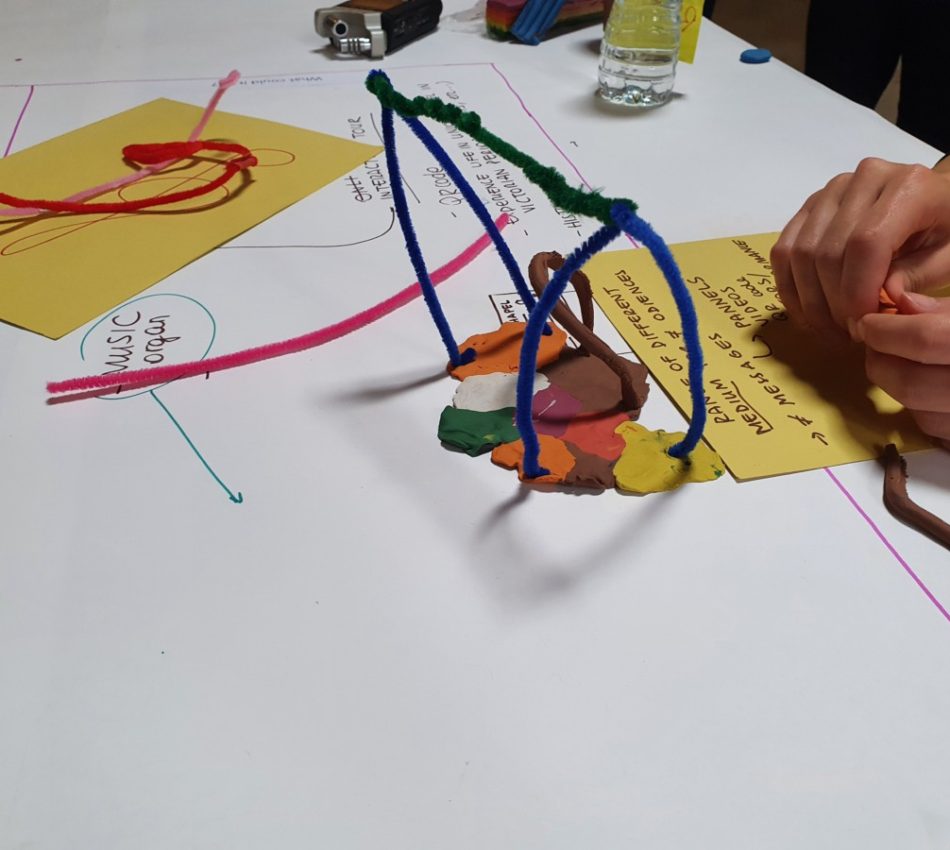Written by:
On Thursday 15 July, The Glass-House worked alongside members of Union Chapel’s team to plan and deliver a full-day, in-person workshop in the beautiful Grade II* Listed Sunday School, which forms part of Union Chapel’s complex of buildings in Islington, North London. The workshop was delivered to a varied group of local community members, from long-term users of the Chapel to members of Islington Youth Council who had not visited the building before.
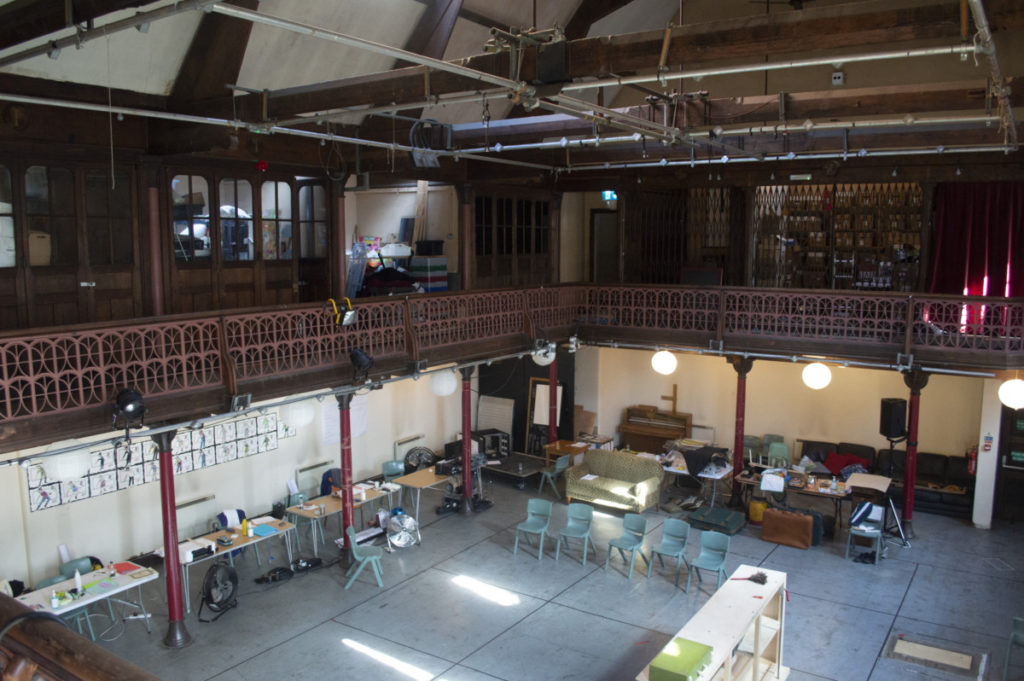
The Sunday School, which sits to the rear of the well known Union Chapel and is accessed directly from Compton Avenue, is due a substantial refurbishment which will include the planning and production of an interpretation piece to showcase the building’s history and help visitors make sense of the building around them. The Sunday School was built alongside the Chapel in 1877 as a place of education in Victorian London, and has seen a myriad of uses across the years which have added to the spaces colourful history and current condition. The workshop aimed to help shape a brief for this interpretation piece, involving a diverse range of local people and organisations to help unpick what is special about the Sunday School, what stories from the past, present and future could be embedded and highlighted through the piece and how it could connect with the wider community in Islington. The results of the workshop will form part of the next stage of a funding application to the National Heritage Lottery Fund (NHLF), which if successful will secure the future of the Sunday School Stories Project.
Exploring the physical history
Recognising the need to understand the relationship between Union Chapel and the Sunday School, we started the workshop with a quick tour of the Chapel led by Barbara Basini, Head of Conversation and Building Projects. Physically experiencing the linking spaces between the two allowed participants to understand the relationship between them, before we took everyone back into the Sunday School space to watch a brief video which gave an overview of the history of the building and the original aims of the Sunday School. Produced by Union Chapel, the video is available to watch here, and provides an excellent introduction to the stories and heritage of the Sunday School.
We then armed participants with post-it notes, and invited them to explore the ground and mezzanine levels in the Sunday School whilst placing sticky notes on anything that caught their eye, be it furniture, building features or materials in the space. Giving our attendees the space to explore the Sunday School on their own terms allowed them to understand organically what they were interested in about the room, and we were impressed by the range of items and surfaces that were tagged in this activity. We then brought everyone back together to discuss the sticky notes, identifying popular choices (most participants were interested in the original furniture in the room, the amazing roof structure made up of original exposed timber beams and the ornate railing which lines the mezzanine level) through to the less noticed details, like the eclectic light fittings made up of original gas light fittings adapted to fit modern light bulbs in.

Barbara acted as our live heritage consultant during this discussion, giving a quick background on the known history of each of the highlighted aspects of the Sunday School. An interesting point that emerged through this discussion was that although Union Chapel and the Sunday School have been a much loved aspect of the Islington community for more than 200 years, some historical knowledge and stories from the space have been lost through the years. Not much is known about the numbering above the booths on the mezzanine level, or when the timber folding panels were added to a few of these booth fronts.
Mapping the surrounding community
Coming back from a short morning break, the participants were split and seated around two tables which each featured a large A0 map of Islington. Armed with Sharpies, coloured dots and labels, we asked them to annotate on features of their local community; buildings and venues, social or cultural activities, groups and organisations, community assets and services.
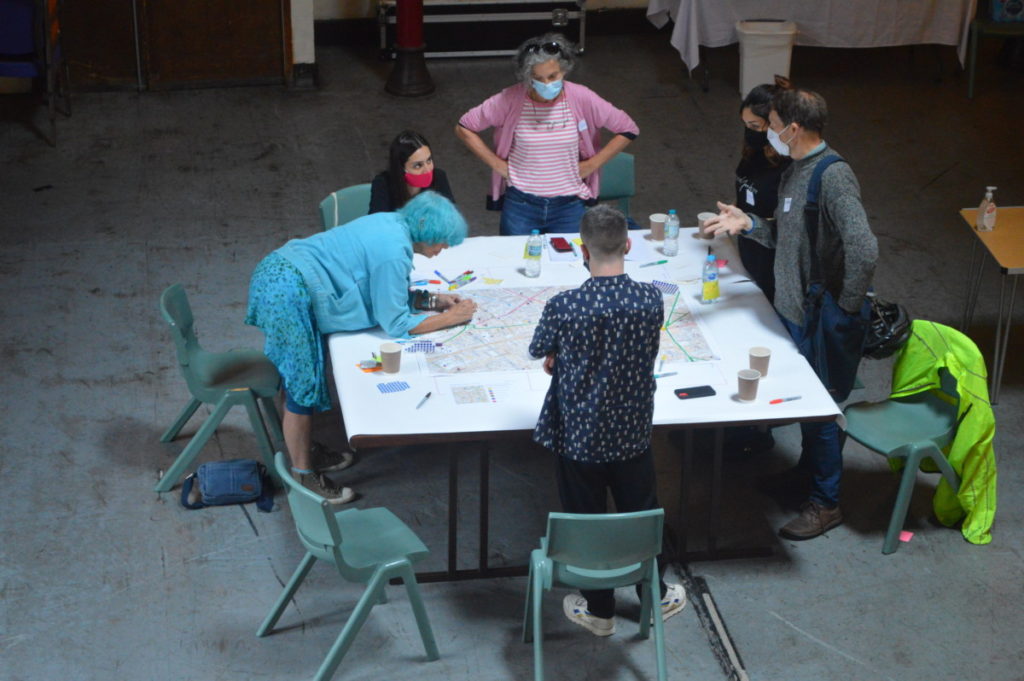
There were an impressive range of features identified; local Churches which ran food banks and other services, several youth groups, small gardens and community groups were all identified during the participants’ discussions. Joining the conversations on each table together, we used a map backed with foam board to create a shared asset map, inviting participants to use pins to locate the asset with a written label identifying the name of each asset. As each participant added their pin, discussion emerged about the audiences targeted by each asset, which groups worked together and some of the historical context of Islington itself.

What’s missing?
This discussion then evolved into identifying what wasn’t mapped, what assets or activities were missing from the map, and considering how the Sunday School, in both its physicality and programme, could bridge this gap. A key community service deemed to be missing from the local Islington area by the participants in the room were services for older people, both social opportunities and more specialist services for those suffering from issues such as dementia. One participant remembered fondly the open concerts Union Chapel would host pre-Covid which she brought her mother, where anyone could drop into the Chapel space to hear live music between 12 – 2pm on Saturdays. This discussion around services for older people naturally touched upon the impact of Covid-19, and how those without a digital presence were most affected by the loss of physical community and had become the most isolated during the pandemic, and that Islington lacked a physical space where people could discuss upcoming events and workshops, and what was going on in the area around the Sunday School.
We then ended the intense morning session and took the participants to the Lower Hall where we enjoyed a fantastic lunch provided by The Margins Project, who offer a range of services to support people facing homelessness and crisis in Islington in their hour of need and with their long-term recovery.
Interpretation pieces
Returning to the Sunday School for the afternoon session, we re-welcomed the participants into the room with a second video from Union Chapel, this time focusing on the Sunday School Project, history of the space and the future plans. This allowed the participants a deeper understanding of the objectives of this project, and prompted them to start to consider how the interpretation piece might fit into this larger tapestry of work. Using a short presentation, we then formally introduced the idea of an interpretation piece, from the more traditional fixed panels that are a frequent sight across parks, historic spaces and popular areas in London and across the UK, through to less traditional forms such as the ‘picture view’ panels in Chiswick House and Gardens and introducing examples which address contested heritage. Going through a series of example interpretation panels and pieces, we opened up the discussion to the whole room to begin a conversation about what struck them about the examples, what they felt worked really well and what the limitations or issues might be in some of the forms.
Through this open discussion, the participants began to consider the characteristics of the interpretation piece, and how key values could be embedded into it. Using a Miro board, we captured the key points of this facilitated discussion live as a base for the next activity. Participants raised some great points, like ensuring that the interpretation panel was pitched for different levels and types of learning, but also discussed how to interpret the Victorian building in today’s society.

Creative visioning through crafting
Following on from this fruitful discussion, we then introduced the creative task where we asked the participants to vision and model their ideas for what the interpretation piece could be using craft materials, pipe cleaners, plasticine, card and tape. We covered the tables at the start of the workshop with large sheets of paper, which we then drew a working space divided into 5 areas, each one addressing one of the following questions: What could it be? What should it do? How should it work? Who should it engage? And finally Where could it be? Space was created in the center of these notetaking areas to model in, with the participants working through these questions to then collectively model their idea in the centre.
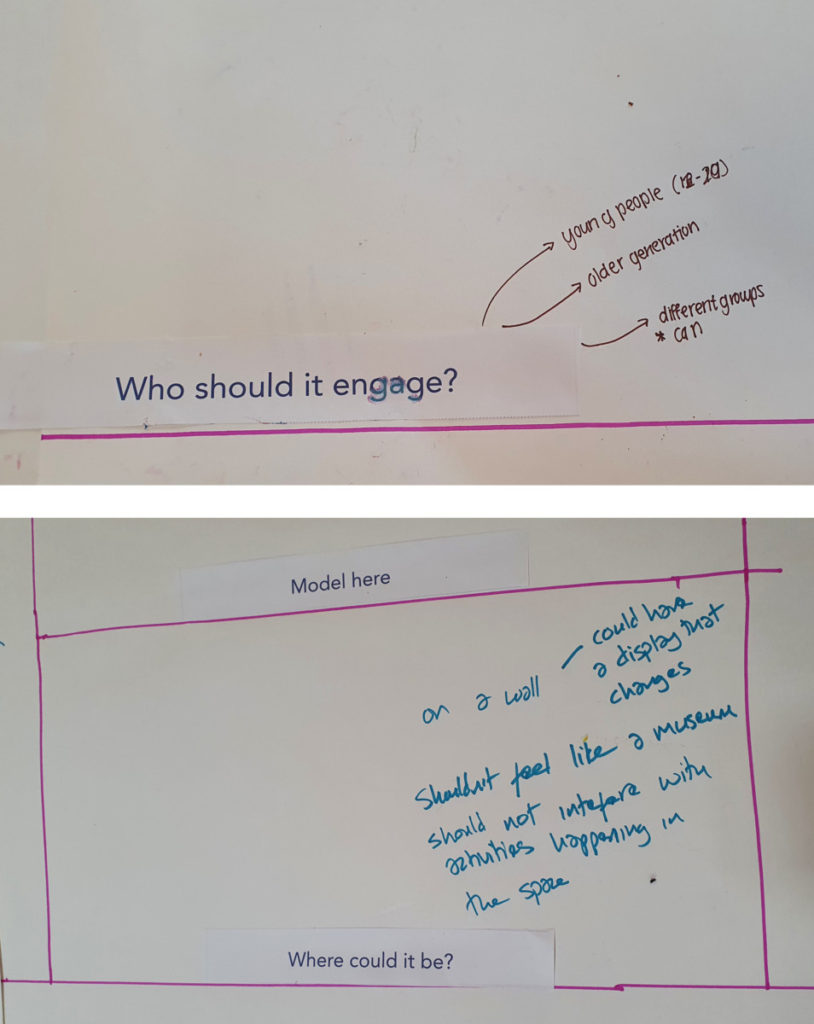
This activity prompted rich discussion, and although it took participants a while to get stuck in with the modelling activity, having something to do with their hands kept the conversation flowing and moving between some fantastic ideas. The younger participants loved the upper booths on the mezzanine levels, and saw the interpretation piece as an opportunity to transform those spaces into more informal areas where representatives from Union Chapel, or other organisations, might occupy with more of a drop in feel. They were keen to avoid the interpretation piece and programme feeling ‘like school’, and wanted engagement to be a conscious choice for visitors. They were also keen to retain the key functionality of the Sunday School space, and developed an idea for the interpretation piece to span across one of the walls. Made up of a mix of posters, shelves with curiosities, a community noticeboard, photos and QR codes to layer further digital information, the ‘wall of interpretation’ would remain ever changing and interactive, allowing members of the local community to add events information whilst not interfering with the core spaces of the Sunday School.
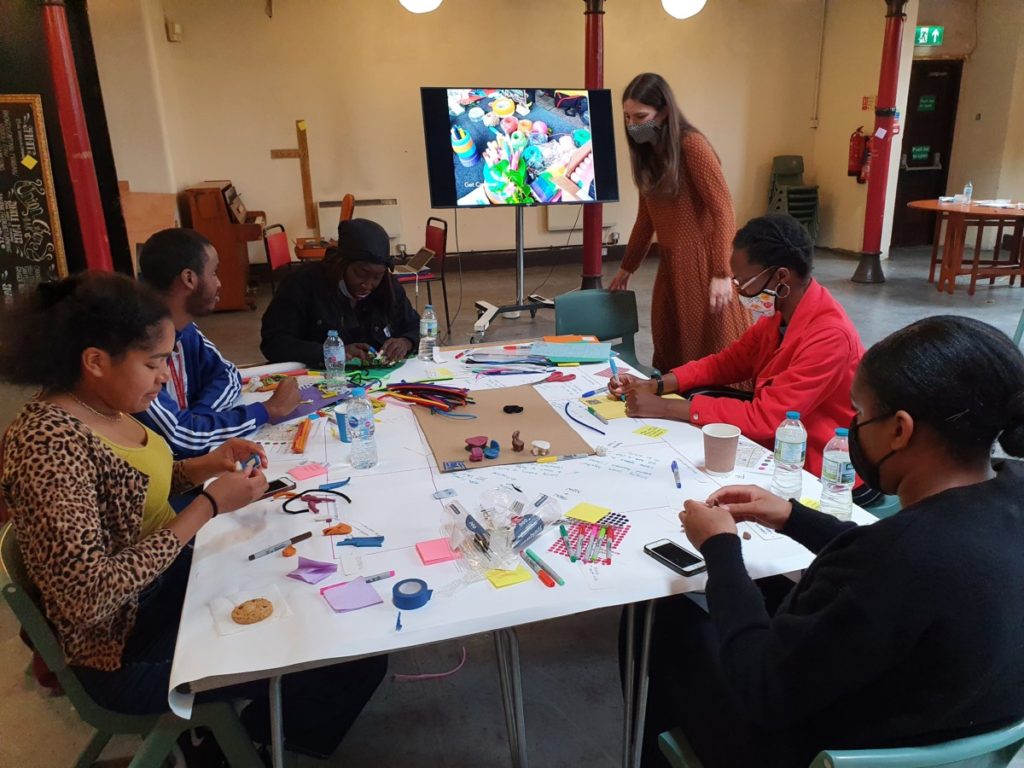
An Interpretation Manifesto
Joining both tables back together for a final discussion about each participant’s models, we developed an ‘Interpretation Manifesto’, which identified the core features that participants wanted to see in the Sunday School’s interpretation piece identified through discussion and the creative task. These included interactive and multigenerational, multi-use and layered information, inviting members of the local community to create content and that the piece should open up the space to make it friendly and welcoming. We were impressed with the range of ideas, and how with this round up discussion we were able to pull common themes and threads from every participant’s work to form a representative manifesto.
By creating a clear journey of exploration, mapping, learning and creating through this workshop, we were able to engage with some fantastic local people whose ideas and thoughts will help form the next stage of the Sunday School Project at Union Chapel. We are so grateful to everyone who attended on the day, as well as to Union Chapel for inviting us into this space.
Keep an eye on Union Chapel’s website for up to date information about events and projects at Union Chapel, and on our resources page as we work to develop a more detailed report about this workshop. You can explore the story of our previous workshop with Union Chapel here, where we worked with local primary school children to help them understand and explore the heritage at Union Chapel. Read Barbara Basini’s blog about the heritage workshop here.

